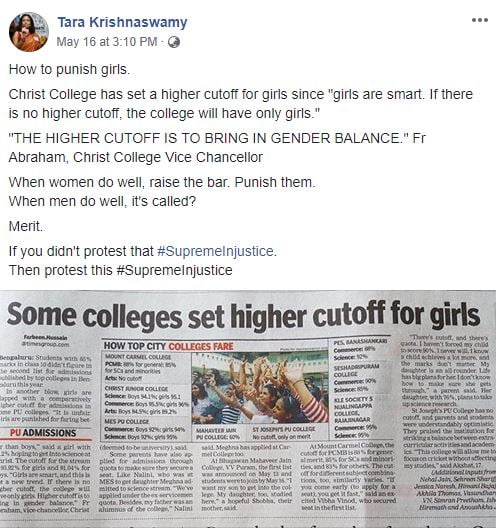On 16th May 2019, Times of India published an article that highlighted that some colleges in Bangalore have kept higher cut-offs for young women than for men for admission into pre-University courses in 2019.
The Department of Pre-University Education of the Karnataka state government had issued guidelines to PU colleges to ensure that they follow a seat matrix in order to maintain an “equal number of women and men” in government and government-aided educational institutions. This order was primarily introduced to ensure that more girl students have access to education. However, this same rule has been turned on its head by some educational institutes in Bangalore.
Some of Bangalore’s pre-university colleges, also known as junior colleges, have been keeping higher cut-offs for women than for men continuously for the past few years. And they have been justifying it as a measure to tackle the “problem of too many women” and to maintain “an equal number of women and men”.
Here is what the Vice-Chancellor of Bangalore’s Christ University, Father Abraham, had to say about the same, “Girls are smart, and this is not a new trend. If there is no higher cutoff, the college will have only girls. Higher cut-offs are to bring in gender balance”.
An outburst against this statement and against the measures adopted by these colleges first broke out when the author and activist Tara Krishnaswamy, who is also the co-founder of Political Shakti and Citizens for Bangalore posted about it on her Facebook handle. Many comments on the post showed anger and disbelief against the decision of these colleges to set higher cut-offs for young women.

However, there also were many comments which were in support of the decision of these Universities. In this article, I will attempt to highlight the frivolousness of these comments and will attempt to prove that the decision to set higher cut-offs for women is a discriminatory as well as regressive.
“It is important to maintain equality”
Like the Vice-Chancellor of Bangalore’s Christ University, many people who supported the decision to keep higher cut-offs for women did so with the belief that it is important to maintain equality. They believed that it wasn’t right to have a higher number of women in the classes. And to prevent that from happening, they believed that it was important to make entry of men into these educational institutions easier.
According to me, this stand is lopsided because of many reasons. Let us start from the basics. When we talk about “equality” and “an equal number of women and men”, I believe that it becomes important to bring in statistics from different spheres of life. If one questions the representation of different genders in a single classroom, they should look at the question of representation in different fields at the national level as well.
It is like punishing women for having performed well and not letting their efforts take shape.
Let us begin with education itself. There is a significant gap in the number of boys (86.2%) and the number of girls (72.8%) enrolled in primary schools. More number of girls than boys drop out of schools because they are made to pursue household work. Only 48% of women have completed the basic five years of primary schooling in India. And only 39% of the female population above 25 years of age has secondary education, whereas the same data for men is 64%.
Let us now move to employment. India ranks 139 out of 145 in the economic participation of women. Over 60% of job advertisements in India explicitly state that they prefer male workers. In many cases, women are denied jobs based on their marital and motherhood status. While the labour force participation rate for men is 78.8% the same for women is 27.2%. In the current parliament, only 11% of MPs are women; this means that 9 out of every 10 parliamentarians are men.
And even after women gain entry into these different fields, the number of problems that they face is plenty. The discrepancy in terms of decision-making power, wage discrimination, inability to gain higher position, gender bias, opportunity gaps, lack of role models, work-family balance, and mental as well as physical harassment, all against women have been well documented.
The fact that most positions of power have been dominated by men for centuries shows that different discourses have always been in their favour. Laws, medical practices, textbooks, have been made in a manner that favours their opinion and position. This in turn again creates discrimination against women. It makes it difficult for women to claim their rights in tough situations. So even if women are able to enter into a few educational institutions because of their better performance it doesn’t necessarily lead to proportionate representation in different spheres.
Thus, those who say that “times are changing” and “girls are smarter” and that women no longer need help, should take a moment to stop and consider these facts. They need to acknowledge that in a situation when literacy levels, economic participation, and decision-making powers are all in favour of men then having higher cut-offs for women is a form of discrimination. It is like punishing women for having performed well and not letting their efforts take shape.
“What about institutions that exist for girls and women exclusively?”
Many people who support the decision of colleges to set up higher cut-offs for women gave the reason that women already enjoy the support of many educational institutions where admission is exclusively reserved for them. They basically gave the excuse of women’s colleges or girls’ schools that exist in India.
For these people, I have one thing to say: segregated spaces for women are a matter of rights, not of charity. Thus, seeing these spaces as undue advantages is highly problematic.
Let us go back to the beginnings of women’s institutions. Their origin itself has been patriarchal, Victorian, and Brahmanical. They began with the aim to present a certain image of the nation and of its women by teaching them soft skills in schools that later became convents. Women were taught sewing, cooking, reading, and other skills which would later make them good “housekeepers”. All of this to keep them relegated into the private sphere, away from the “public sphere of men”. And these spaces were consciously physically made away from the male educational spaces in order to ensure that men do not get “disturbed”. So when you say that women already have spaces for themselves, do also remember their patriarchal origins, why did they come up in the first place.
It was only in the later years when women of these institutions began taking up disciplines that were earlier reserved for men that they became empowering spaces. These institutions made available for women courses that were of their interest and helped in countering the lack of women representation in male-dominated fields of study. In India, where female literacy is still alarmingly low, these colleges allowed women to gain education because of a sense of safety that they had to offer. These spaces became a comparatively safer zone for women away from the male-dominated spheres where women are constantly made to feel uncomfortable through gazes, molestation, and harassment. Basically, these spaces have been and continue to be important for the growth and empowerment of women.
Having said all of this, while acknowledging the importance of women’s institutions, it is also important to acknowledge the fact that their existence does not mean that women have to be relegated to them and only them. What I mean to say is that just because these institutions exist doesn’t mean that all women should be bound to them. In the end, I should be allowed to not choose a women’s only space. The eventual aim of segregated spaces has always been a reintegration into a mixed environment where the marginalised can continue to feel safe and empowered.
So yes, women’s educational institutions exist. But they exist because patriarchy exists. And their existence doesn’t mean that women should be limited to them.
“What about the advantages women enjoy in IITs and IIMs?”
This common reason given to support the higher cut-offs for women can simply be countered by one point: institutions like IIMs and IITs have been massively dominated by men for ages!
It is only when women enter into different fields that conversations will become more diverse.
Since the beginning, women are discouraged from entering into fields that are considered to be “male realms”. They are made to choose subjects that are considered “easy”. The massive commercialisation of education leads to a higher competition which has the worst effect on female students. All of this is apparent by the fact that despite the concessions given to female students in these institutions, their presence is still minimal.
It is only when women enter into different fields that conversations will become more diverse. This will bring in not only a quantitative but also a qualitative change in the atmosphere of educational spaces. It will have an impact on the discourses around different issues and subjects.
“Admissions should be based on merit”
A lot of people who were against the decision of colleges to keep higher cut-offs for women based their stance on the claim that they are not in favour of any “support” and only believe in “merit”. This stance, though against the higher cut-offs for women, is again problematic.
Affirmative action, in the form of reservation or lower cut-offs, is given to the marginalised who have been discriminated against for ages based on the unfair social structures prevalent in our society. It is given to uplift those who have not had the opportunities and access that other students have had in terms of education and other resources. In this case, the higher cut-offs for women act as affirmative action for men. This is unfortunate because it counters the entire basis of affirmative action itself. This makes the setting up of higher cut-offs for women illegal and discriminatory.
Regardless of this, it is important to not dismiss the entire idea of affirmative action altogether. Because deep-rooted discriminatory social structures, like brahminical patriarchy, have systematically denied opportunities to many. Because of this, some sections of society have enjoyed capital – economical, cultural, social – in many fields. Affirmative action attempts to act as an equalising measure for those who have been devoid of this.
Also read: How LSR and Other Women’s Colleges Limit Their Students
So even though, it is important to question the decision of these colleges to give higher cut-offs for women, it is also important to not do it based on the reason of “merit”.
Join Jhatkaa.org to ask the Department of PU Education, Karnataka & the UGC to retract this discriminatory rule. MISSED CALL 7338730688 or Click here.
Featured Image Source: Bes Online
About the author(s)
Kavya is currently pursuing her MA in Media and Cultural Studies from TISS, Mumbai.





